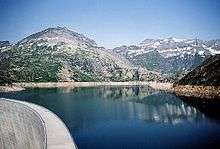Nant de Drance Hydropower Plant
| Nant de Drance | |
|---|---|
 Lac d'Emosson forms the lower reservoir | |
 Location of Nant de Drance in Switzerland | |
| Country | Switzerland |
| Location | Finhaut, Saint-Maurice, Valais |
| Coordinates | 46°3′49.18″N 6°54′39.73″E / 46.0636611°N 6.9110361°ECoordinates: 46°3′49.18″N 6°54′39.73″E / 46.0636611°N 6.9110361°E |
| Status | Under construction |
| Construction began | September 2008 |
| Commission date | 2018-2020 (est.) |
| Construction cost | US$2.1 billion (CHF 1.9 billion, €1.5 billion) |
| Owner(s) | Nant de Drance SA |
| Pumped-storage power station | |
| Upper reservoir | Lac du Vieux Emosson |
| Upper res. capacity | 25,000,000 m3 (20,000 acre·ft) |
| Lower reservoir | Lac d'Emosson |
| Lower res. capacity | 227,000,000 m3 (184,000 acre·ft) |
| Hydraulic head | 425 m (1,394 ft) |
| Pump-generators | 6 x 150 MW reversible Francis-type |
| Power generation | |
| Nameplate capacity | 900 MW |
| Average generation | 2,500 GWh (est.) |
The Nant de Drance Hydropower Plant is a pumped-storage power station currently being constructed in the canton of Valais in Switzerland. It is within the municipality of Finhaut, district of Saint-Maurice and about 14 km (8.7 mi) southwest of Martigny. Construction on the power plant began in 2008 and it should begin operations in 2018. It is owned by Nant de Drance SA, a consortium of Alpiq (39%), SBB (36%), Industrielle Werke Basel (IWB) (15%) and Forces Motrices Valaisannes (FMV) (10%). When complete, the US$1.9 billion plant will have an installed capacity of 900 MW.[1][2]
Background

On 25 August 2008, the Swiss Federal Department of Environment, Transport, Energy and Communications granted a building permit to Nate de Drance SA for the construction of the plant with a 600 MW design. Preliminary construction began in September 2008 but a concession was granted in April 2011 which allowed for a larger 900 MW plant. Excavation of the tunnels began in 2009 and the caverns commenced in 2010.[3] Raising of the upper Vieux Emosson Dam began in Spring 2013 and should be done by the end of 2015. The underground power house excavation was complete in April 2014.[4] The first generators should be tested in 2017 with all six commissioned between 2018 and 2020.[3]
In December 2014, at the International Tunnelling & Underground Space Awards, the project was awarded the Major Tunnelling Project of the Year award in the category of projects over US$500 million.[5]
Design

The power plant will use two existing reservoirs to operate. The lower reservoir, Lac d'Emosson, is formed by the 180 m (590 ft) tall, 555 m (1,821 ft) long Émosson Dam, an arch dam which was completed in 1974. It withholds a reservoir with a storage capacity of 227,000,000 m3 (184,000 acre·ft) and surface area of 327 ha (810 acres). The lower reservoir is 4 km (2.5 mi) long and when full, lies 1,930 m (6,330 ft) above sea level. The upper reservoir for the plant, Lac du Vieux Emosson, is formed by a 45 m (148 ft) tall and 170 m (560 ft) long arch dam originally completed in 1955. The dam is undergoing a raising and will be 65 m (213 ft) tall when done. When raised, Lac du Vieux Emosson's storage capacity will be doubled and it will withhold 25,000,000 m3 (20,000 acre·ft) and have a surface area of 55 ha (140 acres). When full, the upper reservoir will lie 2,225 m (7,300 ft) above sea level.[6]
The power plant will lie in-between both reservoirs and use the pumped-storage hydroelectric method. To accomplish this, when energy demand is high, water will be release from the upper reservoir, down a series of 425 m (1,394 ft) penstocks to the nine 150 MW reversible Francis turbine-generators in the power plant.[6] The large underground power house measures 194 m (636 ft) long, 52 m (171 ft) high and 32 m (105 ft) wide.[4] After generating power, water from the power plant will we discharged to the lower reservoir. When power demand is low, such as at night, the turbines will reverse and water can be pumped back up to the upper reservoir for use during high demand periods. As such, it will serve a peaking power plant.[6]
References
- ↑ "Projet Initié Par Alpiq, CFF, IWB ET FMV" (in French). Nant de Drance SA. Retrieved 11 January 2015.
- ↑ De Clercq, Geert (1 September 2014). "RPT-Cavernous Swiss power plant undermined by renewable energy". Reuters. Retrieved 11 January 2015.
- 1 2 "A New Pumped Storage Plant" (in French). Nante de Drance SA. Retrieved 11 January 2015.
- 1 2 "Nant de Drance". Alpiq. Retrieved 11 January 2015.
- ↑ "The Nant de Drance project wins at the International Tunnelling & Underground Space Awards 2014". BG Group. 11 December 2014. Retrieved 11 January 2015.
- 1 2 3 "The Heart of the Mountain" (in French). Nant de Drance SA. Retrieved 11 January 2015.